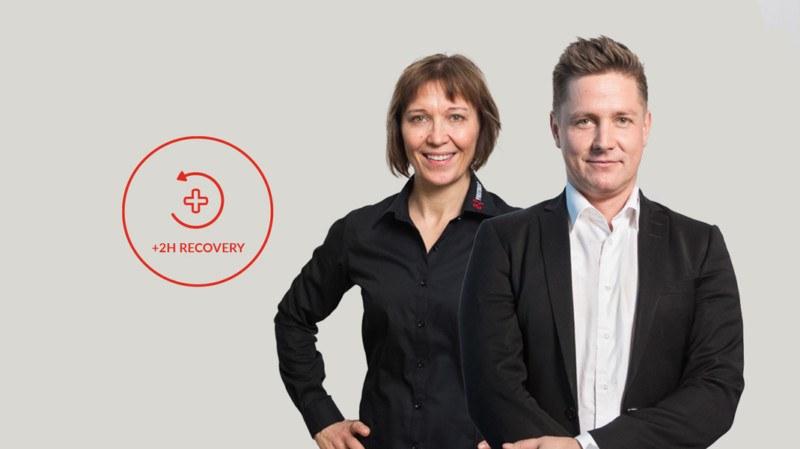
Daily life changed in spring 2020 when the Covid-19 pandemic hit. Millions of people started to work remotely, activities and events were cancelled, and our social life shrank. These changes to our routine have led to changes in our lifestyle, habits and physiology too, as revealed in findings from the Firstbeat database that consists of tens of thousands of measurement days*.
Key takeaways:
- Recovery (per day) has been higher during the pandemic.
- People have slept more (approx. +14 min/night) and woken up later.
- The amount of very inactive – under 1,000 steps – workdays have almost quadrupled.
- Already inactive people have become even more inactive.
Data is based on approx. 26,000 Firstbeat Lifestyle Assessment measurement days (measuring HRV & movement) of working age individuals from April to October 2020. This data has been compared to data from 2017, 2018, and 2019 covering the same months (in total, approx. 180,000 measurement days). Data consists mainly (approx. 70%) of professionals and other office workers’ data and majority (approx. 90%) is from Finland.
Time for Recovery
Despite the uncertainty that COVID-19 has brought, measurement data shows recovery per day has been higher across the entirety of the pandemic than in the same time frame in any of the previous three years. And, somewhat surprisingly, the highest ‘recovery peak’ came in April when the strictest restrictions were in place in many countries. In fact, April saw individuals achieve 30-minutes more recovery per day – the biggest difference between recovery in 2020 versus previous years.
“It may sound strange that the amount of recovery has increased during the pandemic but there are quite natural reasons why,” explains Tero Myllymäki, Head of Physiology Research of Firstbeat.
“Many people can sleep longer because working remotely cuts out commuting time. And, because events and activities have been cancelled, people have had more ‘free time’, especially during the spring. This time may have been spent with the family, in nature or, for example, reading or relaxing. So, this year people have had time for recovery.”
“However, we haven’t seen recovery increase during work hours. Some studies show positives to remote work like less background noise and increased concentration but, on the other hand, taking proper breaks might have been forgotten.”
People Have Slept Longer
Recovery mostly happens during sleep and the increase in recovery seen in the data can be largely attributed to people sleeping more during the pandemic. On average, people have slept for 14 minutes more a night than ‘pre-Covid-19’ with much of this extra sleep taking place in the mornings
“For many, remote work has made it possible to sleep longer because there is less of a rush in the morning with commuting on hold,” Myllymäki explains. “14 minutes more sleep might not sound much but across an entire week it means almost a couple of hours more sleep. This has a big effect on energy level when it is prolonged, as the data seems to show.”
Very Inactive Days on the Rise
There has been a wider discussion about how the pandemic has affected people’s physical activity. For instance, remote work might reduce activity, but it seems that people have been spending more time outdoors – at least when restrictions have allowed.
According to Firstbeat’s big data the total amount of physical activity has settled to the same level as in previous years (excluding when in strictest restrictions). However, the rhythm of physical activity seems to have changed.
Before the coronavirus, more steps – typically around 500 more – were taken on weekdays than at the weekend. But now the trend has reversed, and more steps are taken on Saturday and Sunday than the ‘working week’.

Working at home: Fewer steps are taken at the home office, and therefore the amount of very inactive – under 1,000 steps – days has almost quadrupled.
Looking at the big picture, there is no radical change to the total number of steps taken but it’s concerning that the amount of very inactive workdays has clearly increased. The number of workdays that include under 1,000 steps has almost quadrupled when compared to previous years.
In addition, the level of physical inactivity has increased among those who already classify themselves as ‘not physically active’. 23% of these individuals’ workdays now include fewer than 1,000 steps (vs. 6% previously). Even among people who classify themselves as physically active, they’re hitting fewer than 1,000 steps on 7% of workdays compared to just 2% previously. In general, the average amount of steps for inactive individuals has decreased dramatically by almost 20%, from 3,200 steps to 2,600 steps.
“The further polarization between active and inactive people is really concerning,” warns Myllymäki. “Now, every fourth workday of an inactive individual includes practically no physical activity. As we reach the colder and darker months it becomes really important to find safe ways to exercise. I’d recommend taking some outdoor breaks during remote workdays when possible, or at least walking around the block a couple of times before or after work.”
Perceived Well-being Hasn’t Changed
It’s also interesting to see what hasn’t changed amidst the pandemic. Namely, perceived well-being and stress.
“The perceived well-being results are based on a survey that is done together with the physiological measurement. People are asked about their own feelings of stress and well-being,” says Myllymäki. “50% of the respondents say that they totally or partly agree with the statement ‘I feel stressed’ and this hasn’t changed when compared to previous years.
“Although the uncertainty and restrictions probably concern many of us, there might be less hurry and hassle in everyday life that might balance the situation and our feelings about it.”
Another thing that hasn’t changed this year is self-reported alcohol consumption. The normal yearly trend has been maintained despite media and anecdotal reports of increased alcohol intake.
“Alcohol consumption increases during summer months and decreases in the early fall. When heading to holiday season it increases again – but this year it will be interesting to see how the restrictions affect the situation,” adds Myllymäki.
Of course, the pandemic and its effect aren’t over yet. It will be important to follow how well-being and lifestyle habits develop in the remainder of 2020 and beyond.
“Many of us have found habits that work for us when it comes to things like remote working. Bit, at the same time, people start to be frustrated and bored with the same routine and the absence of typical social life. This may influence both measured and perceived well-being in the future,” concludes Myllymäki.
For further information, please contact:
Alastair Davidson, Content Specialist, Firstbeat
marketing@firstbeat.com
Want to know more about how Firstbeat could support the well-being of your organization? Let’s talk.
You might also be interested in

In Lockdown, Firstbeat Staff Recover Better But Exercise Less
A look at how the Coronavirus lockdown has impacted our staff, using Firstbeat Bodyguard measurement results.


